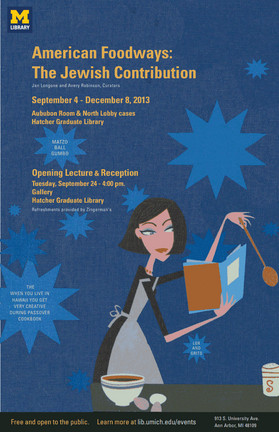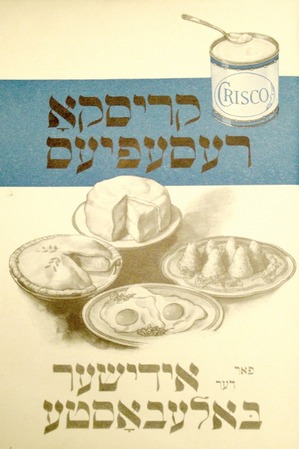American Foodways: The Jewish Contribution

An upcoming exhibit at the University of Michigan is titled "American Foodways: The Jewish Contribution."
photo courtesy of U-M's Hatcher Graduate Library
Yes, indeed, that iconic food is definitely near the top of the list when one considers Jewish contributions to this country's cuisine. But Jews have been in the United States for centuries, and the first kosher butcher arrived in 1660. The first Jewish cookbook was published here in 1871.
Ashkenazi Jews from Europe and Sephardic Jews, descended from those expelled from Spain during the Inquisition, brought dishes from their homelands when they arrived in this country. And, in many instances, these immigrants began feeding their families not only by providing traditional dishes but also with involvement in selling food to earn a living, thus sharing their culture with their neighbors.
There is far more to Jewish cuisine than the famous bagel an' a schmear. And "American Foodways: The Jewish Contribution," an exhibit opening today at the Harlan Hatcher Graduate Library on the University of Michigan campus, will tell the story as it illustrates the enormous influence that Jews and Jewish food have had in this country.
When you go to the exhibit, you'll see more than 200 fascinating items from the University of Michigan's Janice Bluestein Longone Culinary Archive, a world-renowned collection. There are:
- charity/community cookbooks from each of the 50 states (yes, there is even a Jewish fundraising cookbook from Hawaii!)
- classic advertising materials
- cookbooks offering strictly kosher recipes and others that are "kosher style," including one published in Montgomery, Ala. in 1898 that teaches how to cook the distinctly treyf fried squirrel in addition to matzah shortcakes
- the oldest Jewish cookbook published in the United States, as well as the most recent one published only a few weeks ago: Michael Ruhlman's The Book of Schmaltz

Resepyes far der Idisher Baleboste or Recipes for the Jewish Housewife, published in 1933 by Crisco.
- souvenirs and T-shirts from Jewish food festivals and competitions (there are events as far west as Idaho, as far south as Dallas, and as far east as Asheville, N.C.)
- menus from traditional delis to the hippest kosher barbecue joint, Milt's Barbecue for the Perplexed, recently featured in the New York Times' travel section
- and much, much more.
The full depth and breadth of Jewish contributions to American diet and culture are in evidence in this exhibit, which I've been enormously proud to work on since December with curators Jan Longone, Adjunct Curator in the U-M Special Collections Library, and Avery Robinson, Graduate Student in Judaic Studies. The books and other materials being shown are evidence of how this group carved out a distinct identity while simultaneously being a part of and welcoming the larger community.
Jan told me, "I want everyone to come" to see this extraordinary exhibit, because this is not a scholarly array of documents illustrating obscure minutiae, and it is not an insular display that only the Jewish community would have an appreciation for. We all share recipes, we all buy cookbooks, we all sample ethnic dishes, we all go to fairs, we all bond over food. And "American Foodways" is not an exhibit about one single group and its dietary preferences; it is about how this group has been influenced by the larger community, adapting and acclimating its cuisine to new areas, and how it has made its own distinct contributions to our national diet.
"American Foodways" isn't just about Jewish food, but about American food... and people.
American Foodways: The Jewish Contribution
Curated by Jan Longone and Avery Robinson
Sept. 4 - Dec. 8, 2013
Audubon Room, North Lobby Cases, Hatcher Graduate Library
Audubon Room hours:
Monday - Friday: 8:30 a.m. - 7 p.m.
Saturday: 10 a.m. - 6 p.m.
Sunday: 1 - 7 p.m.
Lecture by Jan Longone to be held on Tuesday, Sept. 24 at 4 p.m., followed by a reception, with refreshments provided by Zingerman's. Volunteers with the Janice Bluestein Longone Culinary Archive (including me) will be available at 3 p.m. ahead of the lecture.

The phrase "You Should Only Be Happy" (written in Hebrew on the stone pictured in this post) comes from Deuteronomy 16:15 and is a wish for all her readers - when you come to visit here, may you always be happy.


Comments
Billy
Wed, Sep 4, 2013 : 12:31 p.m.
"What is the first thing you think of when you read those words? Bagels?" Never really considered bagels jewish. I think blintz, I think matzoh and everything you make with it, I think latkes, I think gefilte fish, I think Kreplach or even....oh I need to stop, now I've made my self extra hungry.
Mary Bilyeu
Sat, Sep 7, 2013 : 3:10 p.m.
Bagels have become so assimilated that it's hard to remember their roots; but in poring through the documents and ephemera for this exhibit, I found a booklet from Lender's telling the story of how this Jewish food became an American one. And you clearly know a lot about Jewish food - your list has made ME hungry, too!